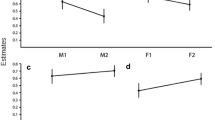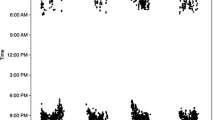Abstract
Breeding records of 11 taxa of captive lemurs housed at the Duke University Primate Center (DUPC), North Carolina, were analyzed for differences in the timing of births, for the relationship between breeding season and photoperiod, and for differences in litter size. At DUPC there are significant differences in the timing of births among certain taxa, including differences among some subspecies of Lemur fulvus.However, changes in latitude result in changes in the timing of the breeding season. Lemurs moved to higher latitudes mate at lower light-dark ratios than on Madagascar. The data presented here are consistent with the following model: a photoperiodic cue initiating reproductive activity, presumably a light-dark threshold, precedes the actual mating season by approximately 2 months, with an intervening period of physiological and social preparation. On Madagascar, selection may have favored births that coincide with the end of dry seasons and the beginning of wet seasons, which results in lactation and weaning during times of resource abundance. Taxa from the north and east have the highest mean litter sizes; those from the west have the lowest.
Similar content being viewed by others
References
Bogart, M. H., Cooper, R. W., and Benirschke, K. (1977a). Reproductive studies of black and ruffed lemurs.Int. Zoo Yrbk. 17: 177–182.
Bogart, M. H., Kumamoto, A. T., and Lasley, B. L. (1977b). A comparison of the reproductive cycle of three species of Lemur.Folia primatol. 28: 134–143.
Boskoff, K. J. (1977). Aspects of reproduction in ruffed lemurs (Lemur variegalus).Folia primatol. 28: 241–250.
Boskoff, K. J. (1978).Reproductive Seasonally and Synchrony in Lemur fulvus, Ph.D. thesis, Duke University, Durham, N.C.
Boskoff, K. J. (1978). The oestrous cycle of the brown lemur,Lemur fulvus.J. Reprod. Fertil. 54: 313–318.
Boskoff, K. J. (1978). Behavioral fluctuations inLemur fulvus: within and without the breeding season. In Chivers, D. J., and Herbert, J. (eds.),Recent Advances in Primatology. Vol. I. Behaviour, Academic Press, London, pp. 503–505.
Budnitz, N., and Dainis, K. (1975).Lemur catta: Ecology and behavior. In Tattersall, I., and Sussman, R. W. (eds.),Lemur Biology, Plenum Press, New York, pp. 219–236.
Bünning, E. (1973).The Physiological Clock: Crcadian Rhythms and Biological Chronometry, 3rd ed., English Universities Press, London.
Evans, C. S., and Goy, R. W. (1968). Social behavior and reproductive cycles in captive ringtailed lemurs (Lemur catta).J. Zool. (Lond.) 156: 181–197.
Flower, S. S. (1933). Breeding season of lemurs.Proc. zool. Soc. Lond. 1933: 317.
Foerg, R. (1982). Reproductive behavior inVarecia variegata.Folia primatol. 38: 108–121.
Harrington, J. E. (1975). Field observations of social behavior ofLemur fulvus fulvus E. Geoffroy 1812. In Tattersall, I., and Sussman, R. W. (eds.),Lemur Biology. Plenum Press, New York, pp. 259–280.
Harrington, J. E. (1978). Diurnal behavior ofLemur mongoz at Ampijoroa, Madagascar.Folia primatol. 29: 291–302.
Jolly, A. (1966).Lemur Behavior: A Madagascar Field Study, University of Chicago Press, Chicago.
Jolly, A. (1967). Breeding synchrony in wildLemur catta. In Altmann, S. A. (ed.),Social Communication Among Primates, University of Chicago Press, Chicago, pp. 3–14.
Lasley, B. L., Bogart, M. H., and Shideler, S. E. (1979). A comparison of lemur ovarian cycles. In Alexander, N. J. (ed.),Animal Models for Research on Contraception and Fertility, Harper and Row, New York, pp. 417–424.
Martin, R. D. (1972). A laboratory breeding colony of the lesser mouse lemur. In Beveridge, W. I. B. (ed.),Breeding Primates, Karger, Basel, pp. 161–171.
Martin, R. D. (1972). A preliminary field-study of the lesser mouse lemur (Microcebus murinus. J. F. Miller 1777). Z.Tierpsychol. 9: 43–89.
Martin, R. D. (1975). Strategies of reproduction.Nat. Hist. 84: 48–57.
Moore-Ede, M. C., Sulzman, F. M., and Fuller, C. A. (1982).The Clocks that Time Us: Physiology of the Circadian Timing System, Harvard University Press, Cambridge, Mass.
Nash, L. T. (1983). Reproductive patterns in galagos (Galago zanzibaricus andGalago garnettii) in relation to climatic variability.Am. J. Primatol. 5: 181–196.
Parry, G. D. (1981). The meanings of r- and K-selection.Oecologia 48: 260–264.
Petter-Rousseaux, A. (1964). Reproductive physiology and behavior of the Lemuroidea. In Buettner-Janusch, J. (ed.),Evolutionary and Genetic Biology of the Primates, Vol. II, Academic Press, New York, pp. 91–132.
Petter-Rousseaux, A. (1970). Observations sur l’influence de la photopériode sur l’activité sexuelle chezMicrocebus murinus (Miller, 1777) en captivité.Ann. Biol. Anim. Biochem. Biophys. 10: 203–208.
Petter-Rousseaux, A. (1972). Application d’un système semestriel de variation de la photopériode chezMicrocebus murinus (Miller, 1777).Ann. Biol. Anim. Biochem. Biophys. 12: 367–375.
Petter-Rousseaux, A. (1974). Photoperiod, sexual activity and body weight variationof Microcebus murinus. In Martin, R. D., Doyle, G. A., and Walker, A. C. (eds.),Prosimian Biology, Duckworth, London, pp. 365–374.
Pittendrigh, C. S., and Minis, D. H. (1964). The entrainment of circadian oscillations by light and their role as photoperiodic clocks.Am. Nat. 98: 261–294.
Tattersall, I. (1982).The Primates of Madagascar, Columbia University Press, New York.
Tattersall, I., and Sussman, R. W. (1975). Observations on the ecology and behavior of the mongoose lemur,Lemur mongoz mongoz Linnaeus (Primates, Lemuriformes) at Ampijoroa, Madagascar.Anthropol. Papers Am. Mus. Nat. Hist. 52: 193–216.
Van Horn, R.N. (1975). Primate breeding season: Photoperiodic regulation in captiveLemur catta.Folia primatol. 24: 203–220.
Van Horn, R.N., and Resko, J. A. (1977). The reproductive cycle of the ring-tailed lemur (Lemur catta): Sex steroid levels and sexual receptivity under controlled photoperiods.Endocrinology 101: 1579–1586.
Zuckerman, S. (1932). The menstrual cycle of primates. VI. Further observations on the breeding of primates with special reference to the subordersLemuroidea andTarsoidea. Proc.zool. Soc. Lond. 1932: 1059–1075.
Author information
Authors and Affiliations
Rights and permissions
About this article
Cite this article
Rasmussen, D.T. A comparative study of breeding seasonality and litter size in eleven taxa of captive lemurs (Lemur andVarecia). Int J Primatol 6, 501–517 (1985). https://doi.org/10.1007/BF02735573
Received:
Revised:
Issue Date:
DOI: https://doi.org/10.1007/BF02735573




